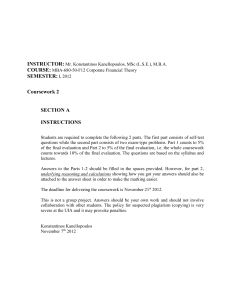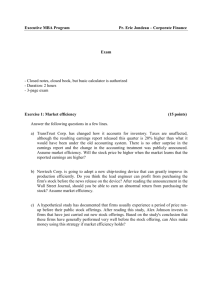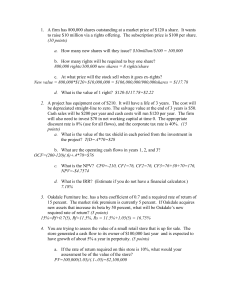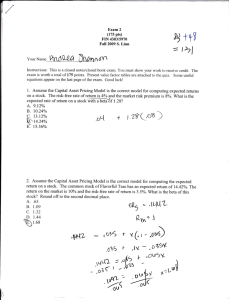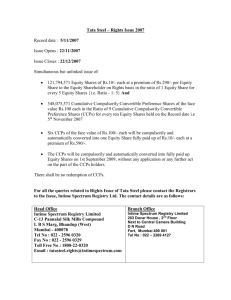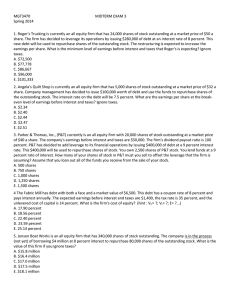Handout 13: MM Propositions I and II (Case with No Taxes
advertisement
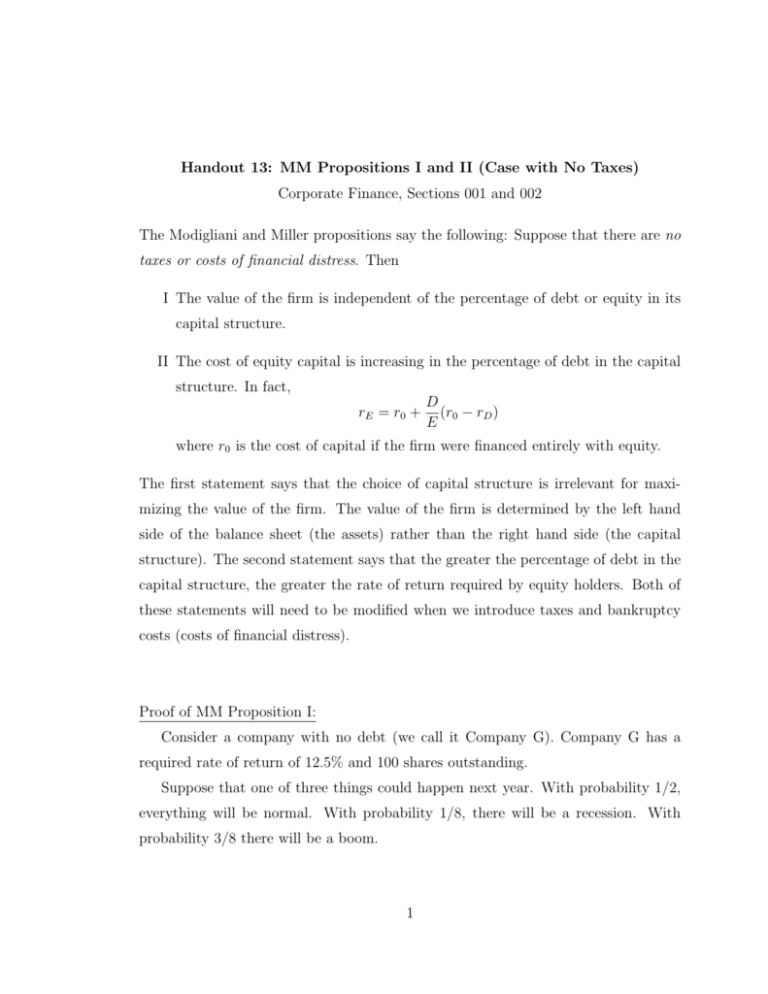
Handout 13: MM Propositions I and II (Case with No Taxes) Corporate Finance, Sections 001 and 002 The Modigliani and Miller propositions say the following: Suppose that there are no taxes or costs of financial distress. Then I The value of the firm is independent of the percentage of debt or equity in its capital structure. II The cost of equity capital is increasing in the percentage of debt in the capital structure. In fact, rE = r 0 + D (r0 − rD ) E where r0 is the cost of capital if the firm were financed entirely with equity. The first statement says that the choice of capital structure is irrelevant for maximizing the value of the firm. The value of the firm is determined by the left hand side of the balance sheet (the assets) rather than the right hand side (the capital structure). The second statement says that the greater the percentage of debt in the capital structure, the greater the rate of return required by equity holders. Both of these statements will need to be modified when we introduce taxes and bankruptcy costs (costs of financial distress). Proof of MM Proposition I: Consider a company with no debt (we call it Company G). Company G has a required rate of return of 12.5% and 100 shares outstanding. Suppose that one of three things could happen next year. With probability 1/2, everything will be normal. With probability 1/8, there will be a recession. With probability 3/8 there will be a boom. 1 Possible outcomes for Company G: Recession Normal Boom 100 250 300 1 2.5 3 Operating income ($) Earnings per share ($) Note that 1 1 3 Expected EPS = 1 + 2.5 + 3 = 250 8 2 8 Suppose these figures are expected to stay the same in perpetuity, and that all earnings are paid out as dividends. Therefore the per-share value of Company G is PG = Expected EPS $2.5 = = $20 r .125 while the total value equals VG = 100PG = $2000 Suppose Company H is identical to Company G in every way (same operating income, number of shares outstanding, required rate of return, and therefore price). Company H decides that it wants to try to increase value by issuing $1000 of debt and using the proceeds to repurchase shares. Suppose Company H can issue debt at the riskfree rate of 10% (like Company G, its earnings are stable). With $1000, Company H is able to purchase 50 shares, so there are 50 shares outstanding. Possible outcomes for Company H: Recession Normal Boom Operating income ($) 100 250 300 Interest ($) 100 100 100 Equity earnings ($) 0 150 200 Earnings per share ($) 0 3 4 2 We want to show that the value of Company H remains exactly the same as before the repurchase, namely exactly the same as that of Company G. First suppose that the value of Company H under the new capital structure increases. That is VH > $2000 We will show that this is impossible by constructing two strategies with equal future cash flows but different initial outlays. • Strategy 1: Buy one share in Company H Cost: (VH − Value of Debt)/# of shares > $1000/$50 = $20. Cash flows: Recession Normal Boom 0 3 4 Dividends on H • Strategy 2: Buy two shares in Company G and borrow $20 at the riskfree rate to be paid back in equal installments of $2 in perpetuity Cost of Strategy 2: $40 - $20 = $20 Cash flows: Recession Normal Boom Dividends on G 2 5 6 Pay back loan -2 -2 -2 Total 0 3 4 These two strategies cannot exist in equilibrium, because all investors would choose the cheaper strategy and no investor would choose the more expensive strategy. Therefore no investor would buy shares in Company H and its value would fall until it equaled $2000. Changing capital structure cannot increase value. 3 Notes: 1. Another way of stating this proof is that there are two ways to purchase Company H. One way is to purchase shares in Company H directly. Another way is to purchase shares in Company G and borrow money directly. In equilibrium, the two ways of purchasing Company H must be worth the same. 2. In real life, there may not be a perfect substitute so this strategy will not be possible. However, the main idea still holds true: If leverage could increase or decrease the value of the corporation, investors would create “homemade” leverage, and purchase the less expense unlevered company. 3. We could have started with Company G as a leveraged firm and asked whether decreasing leverage could increase value. The answer, of course, is no. The proof is similar to above, except instead of borrowing, the alternative strategy is to lend money. Proof of MM Proposition II: We have shown that, under no taxes or bankruptcy costs, the value of a firm is the same regardless of its capital structure. We will now use this statement to prove Proposition II. Above, we stated that the required rate of return for Company G (an all equity company) is r0 = 12.5%. What is the appropriate discount rate to use for company H’s cash flows? We know its value must be $2000 and that it expects to earn $250 in perpetuity. $2000 = 250 r so r = 12.5% = r0 , the rate of return that would apply if Company H were all equity. Note however, that 12.5% is a rate of return that applies to all of Company H’s assets. 4 The required rate of return on H’s equity will not be the same. Because Company H is levered, its cost of capital is given by the WACC formula: r0 = D E rD + rE D+E D+E Multiplying both sides by (D + E)/E: D+E D r0 = rD + r E E E Re-arranging gives us Proposition II: D D+E r0 − rD E E D D = r 0 + r0 − rD E E D = r0 + (r0 − rD ). E rE = In this example, rE = .125 + $1000 (.125 − .10) = .150 $1000 The equity for H requires a higher rate of return, because H is a levered company. 5
